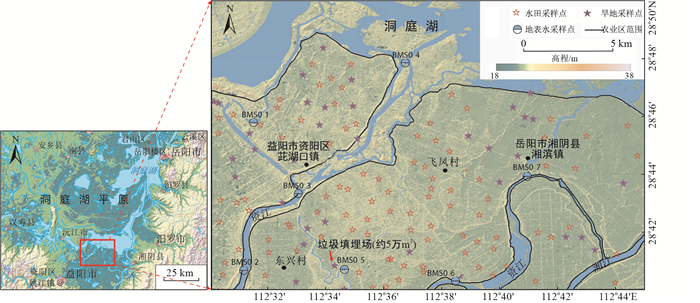Pollution assessment and source analysis of heavy metals in agricultural soil around Zijiang River estuary
-
摘要: 资江是洞庭湖的第二大支流,其中上游锑(Sb)矿采矿冶炼工业发达,给资江下游及洞庭湖区带来了严重的重金属污染风险。以资江河口区为研究区,采集了132个农田土壤样品及7个资江水样,综合采用多种污染评价方法、空间分析、多元统计分析方法对研究区重金属进行了污染评价及来源分析。结果表明,研究区农田土壤重金属平均质量分数表现为Zn>Cr>Ni>Pb>Cu>As>Sb>Cd,旱田土壤重金属平均质量分数除Pb外均高于水田。Sb、As、Cd为主要污染元素,Sb达到了中等污染和中等生态风险的程度,总体处于轻微-中等生态风险程度。资江水体Sb质量浓度较高,平均为10.51 μg/L。Sb主要来源于中上游的锑矿工业,受高锑质量浓度地表水灌溉、垃圾填埋场以及燃煤等人为活动的控制;Cd主要来源于农药化肥、生活垃圾和城镇废水等人为活动;Cr主要来源于成土母质,而Cu、Zn、As、Ni、Pb受成土母质和人为活动的双重控制。Abstract: Zijiang River is the second largest tributary of Dongting Lake. The developed antimony (Sb) mine mining and smelting industry in the upper and middle reaches of Zijiang River bring serious heavy metal pollution risks to the lower reaches of Zijiang River and the Dongting Lake. Taking Zijiang river Estuary as the study area, 132 agriculture soil samples and 7 water samples of Zijiang River were collected, and then multi-methods of contamination assessment, spatial analysis and multivariate statistical analysis methods were comprehensively used to evaluate pollution status and sources of the heavy metal this site. The results showed that the average concentration of heavy metals in farmland soil in the study area was Zn>Cr>Ni>Pb>Cu>As>Sb>Cd, and the average concentration of heavy metals in upland fields was higher than that in paddy fields except for Pb. Sb, As and Cd were the main pollution elements. Besides, Sb reached the level of medium pollution and medium ecological risk, and the site was generally at a slight-medium ecological risk level. The Sb concentration of Zijiang river was relatively high, with an average of 10.51μg/L. Sb mainly came from the antimony mining industry in the upper and middle reaches, and was controlled by human activities such as high antimony concentration surface water irrigation, landfills and coal burning; Cd mainly came from human activities such as pesticides, fertilizers, household garbage and urban wastewater; Cr was mainly derived from soil parent material, while Cu, Zn, As, Ni, Pb were controlled by soil parent material and human activities.
-
Key words:
- Zijiang River estuary /
- agricultural soil /
- heavy metal /
- multivariate statistical analysis /
- antimony
-
表 1 Cf、Cp和Igeo的分级标准[20]
Table 1. Classification criteria for Cf, Cp and Igeo
重金属污染指数Cf 潜在污染指数Cp 地累计指数Igeo 污染程度 < 1 < 1 ≤0 无污染 (1, 3] [1, 3] (0, 1] 轻度-中度污染 (3, 6] (1, 2] 中度污染 (2, 3] 中度-重度污染 > 6 > 3 (3, 4] 重度污染 (4, 5] 重度-极重污染 > 5 极重污染 表 2 潜在生态风险评价分级标准
Table 2. Classification criteria for potential ecological risk assessment
单个重金属的潜在生态危害系数Eri 潜在生态风险指数RI 潜在生态风险程度 < 40 < 150 轻微 [40, 80) [150, 300) 中等 [80, 160) [300, 600] 强 [160, 320] > 600 很强 > 320 极强 表 3 研究区农田土壤重金属元素质量分数统计性结果
Table 3. Statistical results of heavy metal elements in farmland soil in the study area
类型 As Cd Cr Cu Ni Pb Sb Zn 水田 范围 10.70~34.30 0.09~0.92 53.00~88.00 15.80~72.10 18.20~46.20 23.60~73.50 1.70~42.60 33.00~160.00 平均值 17.79 0.40 71.41 27.23 32.06 33.79 6.51 92.31 极差 23.60 0.83 35.00 56.30 28.00 49.90 40.90 127.00 标准偏差 4.12 0.17 7.11 6.48 4.83 7.14 6.89 22.20 变异系数/% 23 43 10 24 15 21 106 24 旱地 范围 13.90~31.80 0.04~1.89 54.00~94.00 21.10~38.40 22.60~60.60 22.00~61.80 1.45~60.30 55.00~127.00 平均值 19.55 0.43 72.06 28.07 36.01 31.36 9.68 95.14 极差 17.90 1.85 40.00 17.30 38.00 39.80 58.85 72.00 标准偏差 4.20 0.34 8.29 3.88 7.09 6.62 14.66 21.21 变异系数/% 21 79 12 14 20 21 151 22 江汉-洞庭平原[23] 10.23 0.15 13.62 18.57 - 20.86 - 84.06 鄱阳湖[24] 13.15 0.18 81.91 38.45 - 35.44 - 80.45 巢湖[25] 5.83 4.27 10.02 15.31 21.33 26.71 - 42.60 成都平原[26] 9.50 0.32 104.00 35.20 39.30 41.40 - 112.00 三江平原[27] 16.87 0.18 69.83 35.28 22.29 18.26 - 68.21 国家土壤环境背景值[28] 9.60 0.08 57.30 20.70 24.90 23.50 1.07 68.00 洞庭湖平原土壤背景值[29] 12.31 0.31 88.20 26.01 26.51 31.69 1.32 86.10 注:表中重金属元素质量分数的范围、平均值、极差单位均为10-6 表 4 研究区潜在生态风险评价结果
Table 4. Evaluation results of potential ecological risks in the study area
As Cd Cr Cu Ni Pb Sb Zn 潜在生态风险指数(RI) 风险级别 单个重金属元素的潜在生态危害指数(Eri) 水田 14.45 38.93 1.62 5.23 6.05 5.33 49.32 1.07 122.00 轻微 旱地 15.88 41.94 1.63 5.40 6.79 4.95 73.32 1.11 151.02 中等 表 5 研究区农田土壤相关性分析结果
Table 5. Results of correlation analysis of farmland soil in the study area
重金属 As Cd Cr Cu Ni Pb Sb Cd 0.331** Cr 0.397** -0.141 Cu 0.330** 0.542** 0.149 Ni 0.550** 0.347* 0.539** 0.517** Pb 0.484** 0.337** 0.385** 0.320** 0.481** Sb 0.344** 0.322** -0.067 0.235* 0.179* 0.173* Zn 0.449** 0.757** 0.103 0.751** 0.636** 0.463** 0.331** 注:**和*分别表示在0.01置信水平(双尾)和0.05置信水平(双尾)下相关性显著 表 6 研究区土壤重金属含量旋转因子载荷
Table 6. Rotation factor loading of heavy metal content in the study area
重金属 PC1 PC2 共同度 As 0.326 0.687 0.647 Cd 0.899 0.004 0.825 Cr -0.216 0.880 0.846 Cu 0.774 0.264 0.723 Ni 0.430 0.748 0.767 Pb 0.337 0.648 0.626 Sb - - - Zn 0.896 0.308 0.925 方差贡献率/% 38.039 34.167 累计方差贡献率/% 38.039 72.206 -
[1] 柯贤忠, 程绪江, 谢淑云, 等. 基于多重分形的表层土壤中重金属元素来源分析: 以海南省琼海市为例[J]. 地质科技情报, 2010, 29(1): 97-102. doi: 10.3969/j.issn.1000-7849.2010.01.016 [2] Marrugo-Negrete J, Pinedo-Hernández J, Díez S. Assessment of heavy metal pollution, spatial distribution and origin in agricultural soils along the Sinú River Basin, Colombia[J]. Environmental Research, 2017, 154: 380-388. doi: 10.1016/j.envres.2017.01.021 [3] 陈能场, 郑煜基, 何晓峰, 等. 《全国土壤污染状况调查公报》探析[J]. 农业环境科学学报, 2017, 36(9): 1689-1692. https://www.cnki.com.cn/Article/CJFDTOTAL-NHBH201709001.htm [4] Goher M E, Farhat H I, Abdo M H, et al. Metal pollution assessment in the surface sediment of Lake Nasser, Egypt[J]. The Egyptian Journal of Aquatic Research, 2014, 40(3): 213-224. doi: 10.1016/j.ejar.2014.09.004 [5] Bai J, Xiao R, Cui B, et al. Assessment of heavy metal pollution in wetland soils from the young and old reclaimed regions in the Pearl River Estuary, South China[J]. Environmental Pollution, 2011, 159(3): 817-824. doi: 10.1016/j.envpol.2010.11.004 [6] Ahmadi-Doabi S, Karami M, Afyuni M. Heavy metal pollution assessment in agricultural soils of Kermanshah Province, Iran[J]. Environmental Earth Sciences, 2019, 78(3): 58-101. doi: 10.1007/s12665-019-8060-3 [7] He J, Yang Y, Christakos G, et al. Assessment of soil heavy metal pollution using stochastic site indicators[J]. Geoderma, 2019, 337: 359-367. doi: 10.1016/j.geoderma.2018.09.038 [8] 吴呈显. 农业土壤重金属污染来源解析技术研究[D]. 杭州: 浙江大学, 2013. [9] Huang Y, Li T, Wu C, et al. An integrated approach to assess heavy metal source apportionment in peri-urban agricultural soils[J]. Journal of Hazardous Materials, 2015, 299: 540-549. doi: 10.1016/j.jhazmat.2015.07.041 [10] Loska K, Wiechula D. Application of principal component analysis for the estimation of source of heavy metal contamination in surface sediments from the Rybnik Reservoir[J]. Chemosphere, 2003, 51(8): 723-733. doi: 10.1016/S0045-6535(03)00187-5 [11] 刘春早, 黄益宗, 雷鸣, 等. 重金属污染评价方法(TCLP)评价资江流域土壤重金属生态风险[J]. 环境化学, 2011, 30(9): 1582-1589. https://www.cnki.com.cn/Article/CJFDTOTAL-HJHX201109011.htm [12] Zhang Z, Zhang N, Li H, et al. Risk assessment, spatial distribution, and source identification of heavy metal(loid)s in paddy soils along the Zijiang River Basin in Hunan Province, China[J]. Journal of Soils and Sediments, 2019, 19(12): 4042-4051. doi: 10.1007/s11368-019-02352-0 [13] Zhang Z, Lu Y, Li H, et al. Assessment of heavy metal contamination, distribution and source identification in the sediments from the Zijiang River, China[J]. Science of the Total Environment, 2018, 645: 235-243. doi: 10.1016/j.scitotenv.2018.07.026 [14] Ahmed F, Fakhruddin A N M, Imam M D T, et al. Spatial distribution and source identification of heavy metal pollution in roadside surface soil: A study of Dhaka Aricha highway, Bangladesh[J]. Ecological Processes, 2016, 5(1): 2-18. doi: 10.1186/s13717-016-0045-5 [15] Tian K, Huang B, Xing Z, et al. Geochemical baseline establishment and ecological risk evaluation of heavy metals in greenhouse soils from Dongtai, China[J]. Ecological Indicators, 2017, 72: 510-520. doi: 10.1016/j.ecolind.2016.08.037 [16] Kumar V, Sharma A, Kaur P, et al. Pollution assessment of heavy metals in soils of India and ecological risk assessment: A state of the art[J]. Chemosphere, 2019, 216: 449-462. doi: 10.1016/j.chemosphere.2018.10.066 [17] Hakanson L. An ecological risk index for aquatic pollution control: A sedimentological approach[J]. Water Research, 1980, 14(8): 975-1001. doi: 10.1016/0043-1354(80)90143-8 [18] Dauvalter V, Rognerud S. Heavy metal pollution in sediments of the Pasvik River drainage[J]. Chemosphere, 2001, 42: 9-18. doi: 10.1016/S0045-6535(00)00094-1 [19] Muller G. Index of geoaccumulation in sediments of the Rhine River[J]. Geojournal, 1969, 2: 108-118. http://ci.nii.ac.jp/naid/10030367619 [20] Yang Q, Li Z, Lu X, et al. A review of soil heavy metal pollution from industrial and agricultural regions in China: Pollution and risk assessment[J]. Science of the Total Environment, 2018, 642: 690-700. doi: 10.1016/j.scitotenv.2018.06.068 [21] Ke X, Gui S, Huang H, et al. Ecological risk assessment and source identification for heavy metals in surface sediment from the Liaohe River protected area, China[J]. Chemosphere, 2017, 175: 473-481. doi: 10.1016/j.chemosphere.2017.02.029 [22] 徐争启, 倪师军, 庹先国, 等. 潜在生态危害指数法评价中重金属毒性系数计算[J]. 环境科学与技术, 2008, 31(2): 112-115. doi: 10.3969/j.issn.1003-6504.2008.02.030 [23] 王斌, 甘义群, 陈秋菊. 江汉平原仙桃地区土壤重金属分布及影响因素研究[J]. 安全与环境工程, 2018, 25(3): 8-14. https://www.cnki.com.cn/Article/CJFDTOTAL-KTAQ201803002.htm [24] 赵杰, 罗志军, 赵越, 等. 环鄱阳湖区农田土壤重金属空间分布及污染评价[J]. 环境科学学报, 2018, 38(6): 2475-2485. https://www.cnki.com.cn/Article/CJFDTOTAL-HJXX201806042.htm [25] 肖武, 隋涛, 王鑫, 等. 巢湖流域典型农田土壤重金属污染评价与地理探测分析[J]. 农业机械学报, 2018, 49(7): 144-152. https://www.cnki.com.cn/Article/CJFDTOTAL-NYJX201807018.htm [26] 王英英, 钱蜀, 邓星亮. 成都平原西部农业土壤中金属元素分布特征研究[J]. 三峡环境与生态, 2012, 34(5): 11-14. doi: 10.3969/j.issn.1674-2842.2012.05.004 [27] 张继舟, 吕品, 于志民, 等. 三江平原农田土壤重金属含量的空间变异与来源分析[J]. 华北农学报, 2014(增刊1): 353-359. https://www.cnki.com.cn/Article/CJFDTOTAL-HBNB2014S1070.htm [28] 魏复盛, 陈静生, 吴燕玉, 等. 中国土壤环境背景值研究[J]. 环境科学, 1991, 4(4): 12-19. https://www.cnki.com.cn/Article/CJFDTOTAL-HJKZ199104006.htm [29] 张建新. 洞庭湖区土壤地球化学基准值与污染等级划分[J]. 物探与化探, 2014, 38(4): 793-799. https://www.cnki.com.cn/Article/CJFDTOTAL-WTYH201404029.htm [30] Mccallum R I. Occupational exposure to antimony compounds[J]. Journal of Environmental Monitoring Jem, 2005, 7(12): 1245. doi: 10.1039/b509118g [31] 中华人民共和国生态环境部. GB15618-2018 土壤环境质量-农用地土壤污染风险管控标准[S]. 北京: 中国环境出版社, 2018. [32] 王天阳, 王国祥. 昆承湖水质参数空间分布特征研究[J]. 环境科学学报, 2007, 27(8): 154-160. https://www.cnki.com.cn/Article/CJFDTOTAL-HJXX200708030.htm [33] 方传棣, 成金华, 赵鹏大, 等. 长江经济带矿区土壤重金属污染特征与评价[J]. 地质科技情报, 2019, 38(5): 230-239. https://www.cnki.com.cn/Article/CJFDTOTAL-DZKQ201905025.htm [34] 汪冬华. 多元统计分析与SPSS应用[M]. 上海: 华东理工大学出版社, 2010. [35] 李立刚, 周建伟, 李伟洁, 等. 某特大型锑矿区废石中锑的释放规律[J]. 地质科技情报, 2018, 37(5): 215-221. https://www.cnki.com.cn/Article/CJFDTOTAL-DZKQ201805030.htm [36] 何孟常, 万红艳. 环境中锑的分布、存在形态及毒性和生物有效性[J]. 化学进展, 2004, 16(1): 131-135. doi: 10.3321/j.issn:1005-281X.2004.01.020 [37] 杨忠芳, 夏学齐, 余涛, 等. 湖南洞庭湖水系As和Cd等重金属元素分布特征及输送通量[J]. 现代地质, 2008, 22(6): 897-908. doi: 10.3969/j.issn.1000-8527.2008.06.001 [38] 江南, 李小倩, 周爱国, 等. pH值和氧化剂对硫化锑氧化溶解的影响机制[J]. 地质科技通报, 2020, 39(4): 76-84. http://dzkjqb.cug.edu.cn/CN/abstract/abstract10002.shtml [39] 卢召艳, 魏晓, 李红, 等. 环洞庭湖区稻田土壤中硅分布特征及其影响因素[J]. 水土保持通报, 2017, 37(4): 27-32. https://www.cnki.com.cn/Article/CJFDTOTAL-STTB201704005.htm [40] Yan H, Wang X, Yang Y, et al. The effect of straw-returning on antimony and arsenic volatilization from paddy soil and accumulation in rice grains[J]. Environmental Pollution, 2020, 263: 114581. doi: 10.1016/j.envpol.2020.114581 [41] 文吉昌, 胥思勤, 张乐乐, 等. 锑和砷在土壤和玉米根、茎、叶、粒中的分布研究[J]. 环境科学与技术, 2016, 39(5): 28-33. https://www.cnki.com.cn/Article/CJFDTOTAL-FJKS201605005.htm [42] Abbas H, Ebrahim P. Heavy metals assessment and identification of their sources in agricultural soils of Southern Tehran, Iran[J]. Environmental Monitoring and Assessment, 2011, 176(1/4): 677-691. doi: 10.1007/s10661-010-1612-3 [43] 秦先燕, 李运怀, 孙跃, 等. 环巢湖典型农业区土壤重金属来源解析[J]. 地球与环境, 2017, 45(4): 455-463. https://www.cnki.com.cn/Article/CJFDTOTAL-DZDQ201704010.htm [44] 银燕春, 王莉淋, 肖鸿, 等. 成都市区、城郊和农村生活垃圾重金属污染特性及来源[J]. 环境工程学报, 2015, 9(1): 392-400. https://www.cnki.com.cn/Article/CJFDTOTAL-HJJZ201501065.htm -





 下载:
下载:











